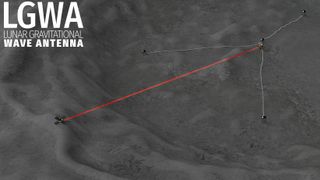Gravitational wave detectors on the moon could be more sensitive than those on Earth
"There are no major technological hurdles to overcome to realize this detector."

Scientists developing more sensitive next-generation gravitational wave detectors struggle with technical challenges that might be easily overcome by putting such detectors on the moon. Here is why a gravitational wave observatory on Earth's natural companion might be a good idea.
Gravitational waves are ripples in spacetime triggered by collisions between the most massive objects known to exist in the universe — black holes and neutron stars, the odd leftovers birthed from the deaths of the most giant stars.
First detected in 2015, these cosmic signals can be picked up by sophisticated detectors such as the U.S. Laser Interferometer Gravitational-Wave Observatory (LIGO) or the European VIRGO detector in Italy. But the current detectors only detect the most powerful and relatively nearby collisions that occurred within 7 billion light-years from Earth, according to Einstein Online.
Scientists are already developing larger, more sensitive machines that would be able to detect even the most distant cosmic clashes, as well as those caused by collisions between smaller black holes and lighter neutron stars. There's one issue: We have yet to figure out how to eliminate the ever-present background noise produced by our planet. One researcher thinks that the problem could be solved by putting a gravitational wave detector on the moon.
Related: We could hunt gravitational waves on the moon if this wild idea takes off
Speaking at the Astronomy from the Moon conference held earlier this year in London, professor Jan Harms, a gravitational wave-detection expert at Italy's Gran Sasso Science Institute, said that since these next-generation detectors want to provide much better sensitivity than LIGO and VIRGO, they need to be not only larger, but also better protected from seismic noise, the constant hum of our planet and the life it harbors.
"Gravitational-wave detectors are sensitive to tiny forces that no other experiment can see, which makes them very susceptible to their environment (even in space and on the moon)," Harms told Space.com in an email. "The moon offers ideal conditions, and we are very lucky that it is so close to Earth. For example, we know that the moon is seismically extremely quiet, above all because of the lack of ocean and atmosphere, but also because moonquakes are less frequent and weaker compared to earthquakes."
Get the Space.com Newsletter
Breaking space news, the latest updates on rocket launches, skywatching events and more!
Moreover, to maximize the sensitivity of these devices, the next-generation gravitational-wave detectors should be cooled to extremely low temperatures close to absolute zero, the temperature equivalent to minus 459.67 degrees Fahrenheit (minus 273.15 degrees Celsius) at which point atoms stop moving. But the cooling technologies required to reach such temperatures create vibrations, which then make it more difficult to detect the subtle space-time ripples.
Inside the moon's permanently shadowed polar craters, on the other hand, temperatures are naturally extremely cold and stable enough to host such sensitive equipment.
"Exploiting these physical conditions on the moon will make it possible to open an important frequency band from 0.1Hz to 1Hz to gravitational-wave observations, which cannot be observed on Earth," Harms explained. "There is a lot of breakthrough science we expect to be able to do with observations in this band."
In addition to sensing merging black holes and neutron stars, a gravitational-wave detector on the moon could be able to spot collisions of smaller, less massive objects, such as white dwarfs, the cooling remnants of smaller stars such as our sun, Harms wrote. Scientists think that such collisions are responsible for certain types of supernovas, the most powerful explosions known to occur in the universe, but they don't yet have any evidence of that.
By being able to observe mergers of smaller black holes at the most distant reaches of the universe, scientists would also be able to fill gaps in their understanding of the formation of supermassive black holes, the gaping monsters devouring matter at the center of galaxies.
"At the moment, we do not have a unique and fully satisfactory answer to how supermassive black holes were formed," Harms added.
Harms and his team are already developing a concept of a lunar gravitational-wave detector, which, Harms believes, could launch to the moon within the next decade. Called the Lunar Gravitational Wave Antenna, the detector would use the entire moon as a giant receptor of gravitational waves. A sensitive sensor placed inside one of the cold, shaded lunar craters would then measure the minuscule vibrations of the moon caused by passing gravitational waves.
"There are no major technological hurdles to overcome to realize this detector," Harms wrote.
Scientists from other astronomy disciplines are looking at the moon and its polar craters as well, seeing them as the best destination that could allow them to push the boundaries of what is possible with existing ground and space-based telescopes. If all these ideas come to fruition, it might soon get a little crowded in those frosty, eternally quiet moon craters.
Join our Space Forums to keep talking space on the latest missions, night sky and more! And if you have a news tip, correction or comment, let us know at: community@space.com.

Tereza is a London-based science and technology journalist, aspiring fiction writer and amateur gymnast. Originally from Prague, the Czech Republic, she spent the first seven years of her career working as a reporter, script-writer and presenter for various TV programmes of the Czech Public Service Television. She later took a career break to pursue further education and added a Master's in Science from the International Space University, France, to her Bachelor's in Journalism and Master's in Cultural Anthropology from Prague's Charles University. She worked as a reporter at the Engineering and Technology magazine, freelanced for a range of publications including Live Science, Space.com, Professional Engineering, Via Satellite and Space News and served as a maternity cover science editor at the European Space Agency.